Book contents
- Frontmatter
- Contents
- Foreword
- Preface
- About the contributors
- Table of cases
- Table of statutes
- 1 Australian administrative law: The constitutional and legal matrix
- 2 Administrative law in Australia: Themes and values
- 3 The public/private distinction in Australian administrative law
- 4 Australian administrative law: The human rights dimension
- 5 Administrative tribunals
- 6 Australian Ombudsman: A continual work in progress
- 7 Freedom of information
- 8 Delegated legislation
- 9 The concept of ‘justiciability’ in administrative law
- 10 Standing
- 11 Reasons for administrative decisions: Legal framework and reform
- 12 Relevant and irrelevant considerations
- 13 Improper purpose
- 14 Reasonableness, rationality and proportionality
- 15 The ‘no evidence’ rule
- 16 Failure to exercise discretion or perform duties
- 17 Procedural fairness: The hearing rule
- 18 The doctrine of substantive unfairness and the review of substantive legitimate expectations
- 19 The impact and significance of Teoh and Lam
- 20 The rule against bias
- 21 Jurisdictional error without the tears
- 22 Privative clauses and the limits of the law
- 23 Administrative law judicial remedies
- Endnotes
- Index
6 - Australian Ombudsman: A continual work in progress
Published online by Cambridge University Press: 05 June 2012
- Frontmatter
- Contents
- Foreword
- Preface
- About the contributors
- Table of cases
- Table of statutes
- 1 Australian administrative law: The constitutional and legal matrix
- 2 Administrative law in Australia: Themes and values
- 3 The public/private distinction in Australian administrative law
- 4 Australian administrative law: The human rights dimension
- 5 Administrative tribunals
- 6 Australian Ombudsman: A continual work in progress
- 7 Freedom of information
- 8 Delegated legislation
- 9 The concept of ‘justiciability’ in administrative law
- 10 Standing
- 11 Reasons for administrative decisions: Legal framework and reform
- 12 Relevant and irrelevant considerations
- 13 Improper purpose
- 14 Reasonableness, rationality and proportionality
- 15 The ‘no evidence’ rule
- 16 Failure to exercise discretion or perform duties
- 17 Procedural fairness: The hearing rule
- 18 The doctrine of substantive unfairness and the review of substantive legitimate expectations
- 19 The impact and significance of Teoh and Lam
- 20 The rule against bias
- 21 Jurisdictional error without the tears
- 22 Privative clauses and the limits of the law
- 23 Administrative law judicial remedies
- Endnotes
- Index
Summary
The transition in the roles, functions and activities of Australian Ombudsman from those contemplated at the start of the 1970s to current practice in 2006 has been remarkable. Early research on the Ombudsman in Australia argued that the office was an alien concept to Australia that had been remarkably successful in terms of receiving and resolving complaints and establishing a good reputation with the public, but that the office had received marginal attention in legal scholarship and had a problematic relationship with other parts of the administrative landscape. Australian Ombudsmen have transformed from an alien (and barely understood) import on the edge of public administration, assigned a secondary and assistant role, to being regarded as a central component of administrative justice. There has been a significant redistribution of focus and activity from an original complainant-focused, incident-based approach to an institution-focused and performance-based approach to investigation.
The administrative law and public administration landscapes in Australia have radically changed since the 1970s. More importantly the rate, extent and impact of those changes continue to compound in the early decades of the twenty-first century. This raises some interesting questions about the capacity of an institution, initially configured as a third-hand antipodean import of a nineteenth century instrument of Swedish law reform, to function in a rapidly changing Australian environment two centuries removed from its Swedish beginnings.
- Type
- Chapter
- Information
- Australian Administrative LawFundamentals, Principles and Doctrines, pp. 100 - 115Publisher: Cambridge University PressPrint publication year: 2007
- 1
- Cited by



